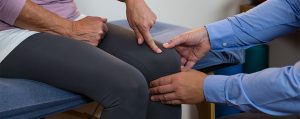Concussions in the Workplace
Approximately 1 in 4 mild traumatic brain injuries (mTBIs) in adults occur at work and are associated with substantial productivity loss, economic burden, persistent symptoms, and occupational disability1. Concussions in the workplace are most commonly caused by falls, getting struck in the head by falling objects, or motor vehicle accidents2. Most adults recover from an mTBI or concussion within 7-10 days; however, individuals who continue to have persistent symptoms beyond this timeframe are more at risk for further co-morbidities, including aerobic deconditioning, chronic pain, anxiety disorder, depression, as well as poor work performance3.
(more…)
Why You Should Try Dry Needling The Next Time You Are In Pain
Trigger point injections have been around since the 1940s, but dry needling has recently become the latest craze. Why? What is dry needling? And how could it help me?
Dry needling has many different philosophies and approaches. Some practitioners will perform trigger point dry needling, others will perform dry needling with needle retention, and some will even use dry needling with electrical stimulation. Ultimately, dry needling, no matter what form it is utilized in, triggers an inflammatory response to the tissue, promoting blood flow and healing.
Can PT Help Prevent Heart Disease?
The short answer is YES! Heart disease is the leading cause of death in the United States. With a widespread problem, we should consider all of our options for prevention.
Physical Therapy After a Heart Attack
An unexpected cardiac event, like a heart attack or an open-heart surgery, is an extremely scary experience. I’ve witnessed this first-hand as I was beside my father when he suffered a heart attack in October 2021. Thankfully, he survived the heart attack, but my father underwent an open-heart surgery quickly after that. His ongoing recovery process has been life-altering for our family, but his commitment to cardiac rehabilitation (cardiac rehab) has been critical in returning to a healthy life. For those of you that are going through this yourself or have loved ones that have experienced a cardiac event, here are some things to consider related to physical therapy after a heart attack:
Common Injuries in the Aging Athlete
More and more health care providers are seeing an increase in “Boomeritis,” a term coined by Nicholas DiNubile in 1999, referring to the musculoskeletal injuries that the aging athlete in the baby boomer generation, 1946-1964, are experiencing. This group of athletes is the first generation to grow up exercising and continue exercising well into their 70s. The musculoskeletal injuries in Boomeritis include tendon, muscle, and ligament tears and stress fractures. While these injuries can happen at any age, physiologic changes with age make this generation more susceptible to developing these problems.
4 Exercises to Strengthen the Rotator Cuff
The rotator cuff is a hot topic when it comes to shoulder injuries. A rotator cuff is an important group of four muscles that help move the shoulder to perform activities of daily living. Damage to one or more of the rotator cuff muscles can become a source of pain, reduced range of motion, reduced strength, or overall function. It is important to keep this muscle group strong to minimize injury and recover from a shoulder injury. Let’s look at some exercises that you can do at home to strengthen the rotator cuff.
Tips from a PT: Returning to Exercise in the New Year
The cookies have been eaten, the shopping is complete, and the gym membership just hit your credit card. Whether for personal growth, maintaining health, or slimming up for summer, millions of Americans will be hitting the gym in January. Unfortunately, many people will also end up quitting or in my office because of nagging pain or new injury. Pain is a sure-fire way to discourage and derail even the best-laid workout plans. This blog will give you tips to keep your workouts consistent and pain-free in the New Year.
When Should I Be Worried About My Pain?
What better time of year than the New Year to start fresh with a few weight loss and fitness goals, right? You are excited, motivated, and ready to make changes. Day one comes, and you put in a great workout. You head home, eat a good dinner, and get to bed excited to get back to the gym the next day. However, as you wake up and take your first step out of bed, you notice your knee hurts and feels a bit swollen. This is odd because you don’t remember your knee hurting yesterday, and you become concerned. Should you be worried? Well, it’s a bit more complicated than that, and the reality is most pain that we experience will disappear and how we label the pain or feel about our pain can affect the outcome.
